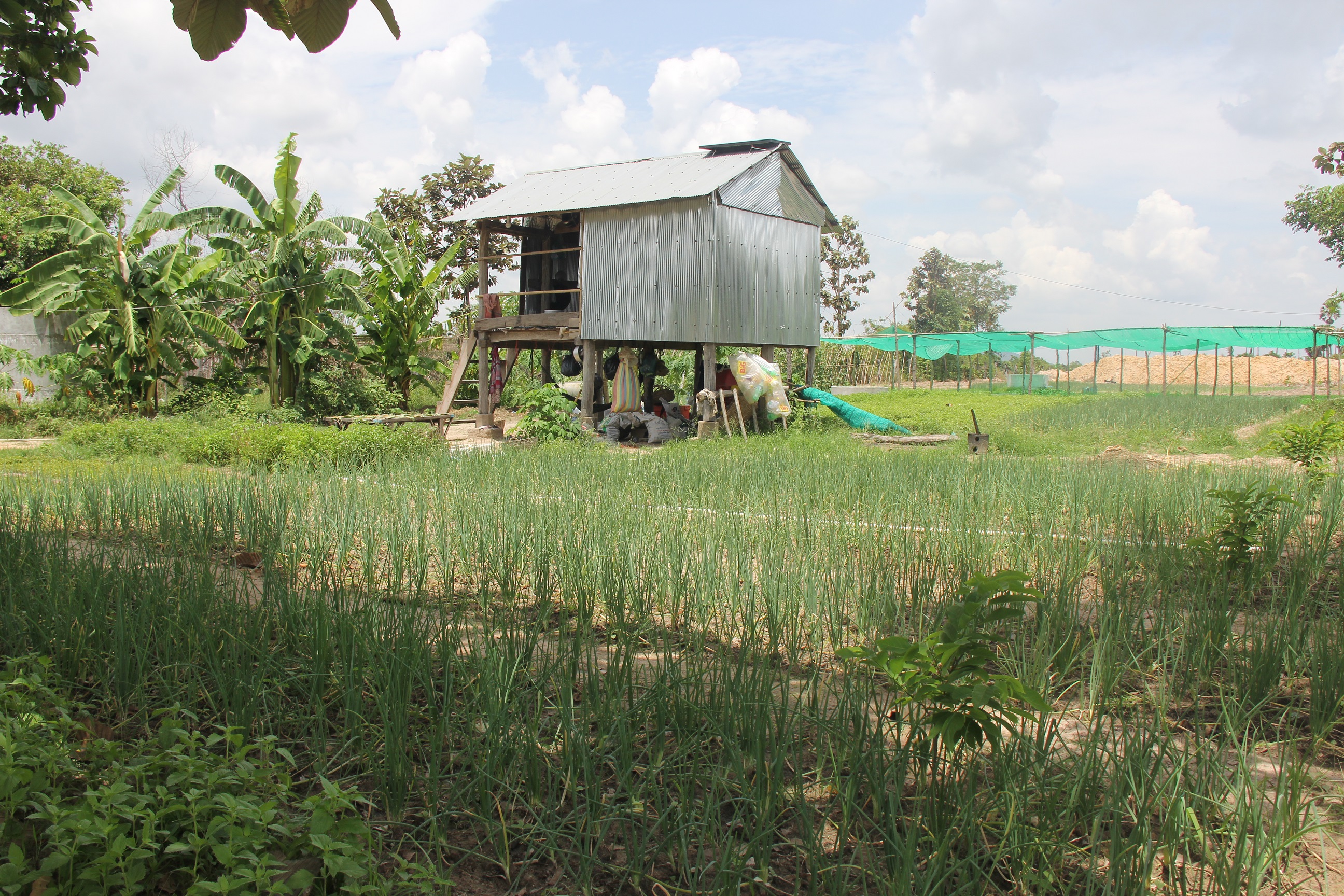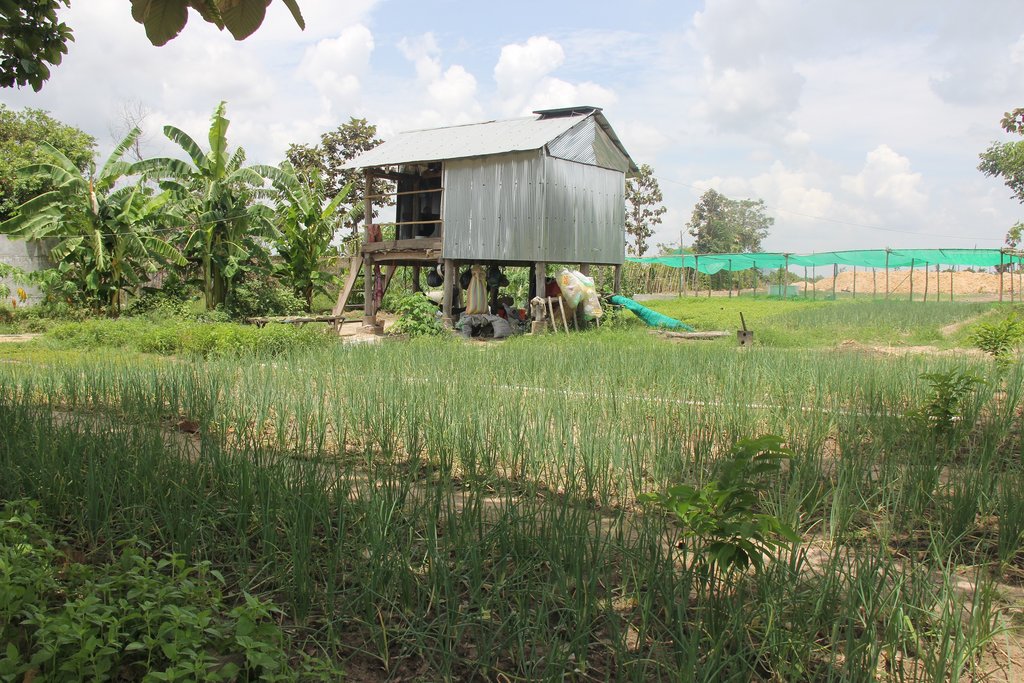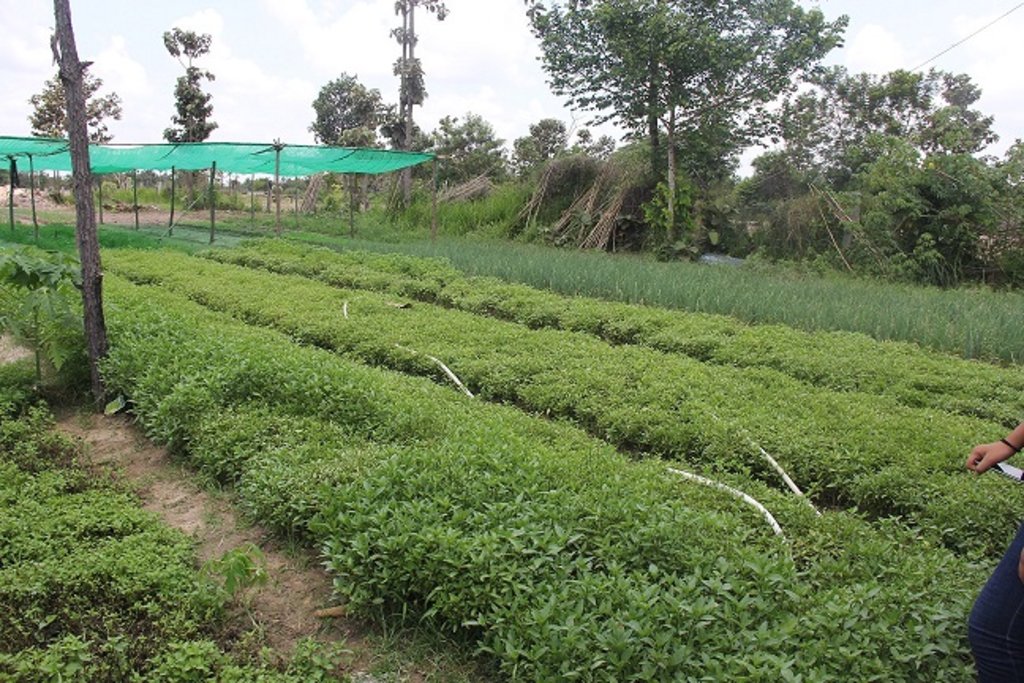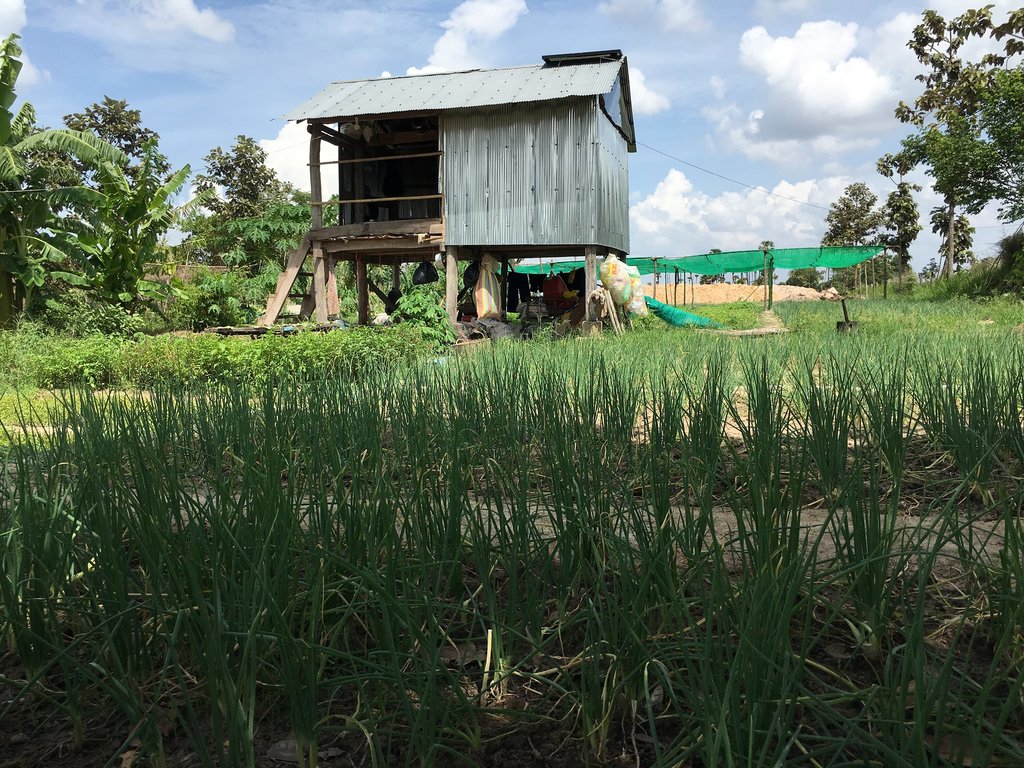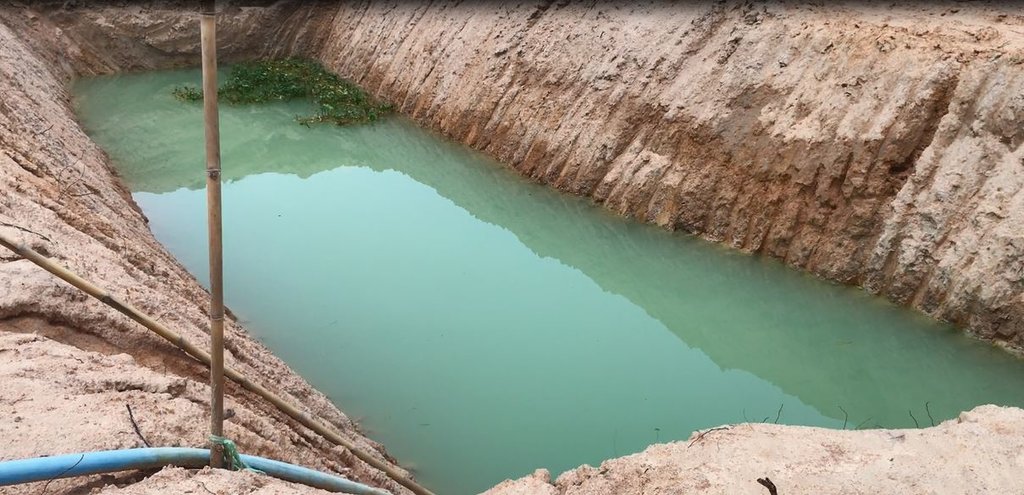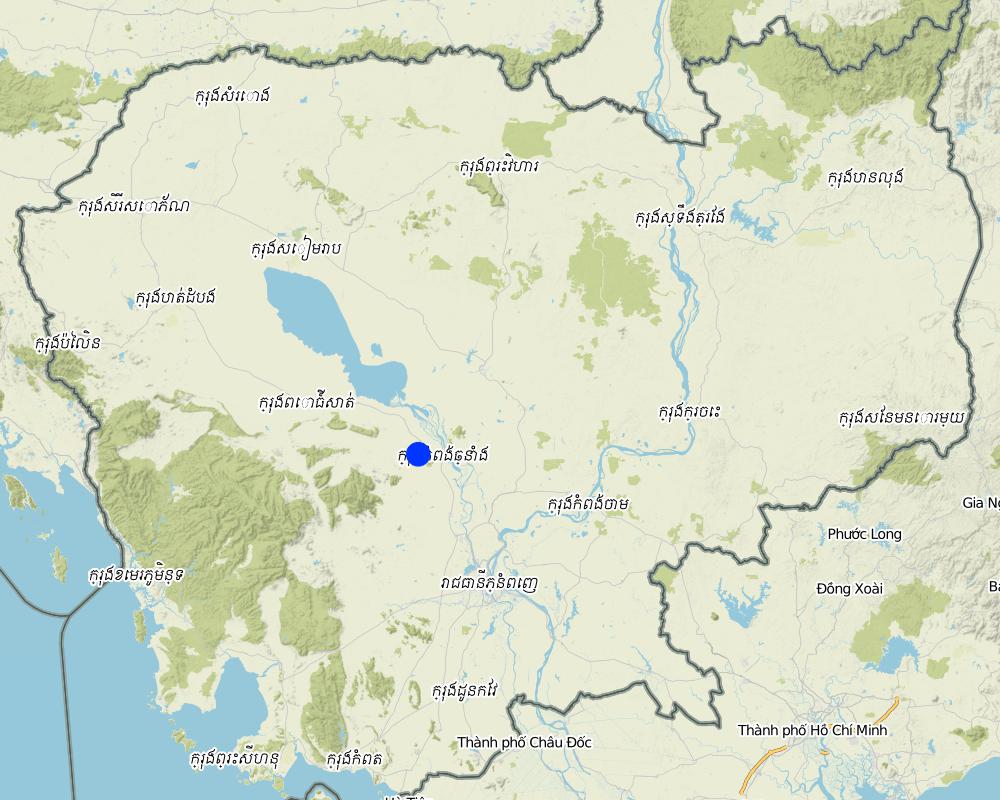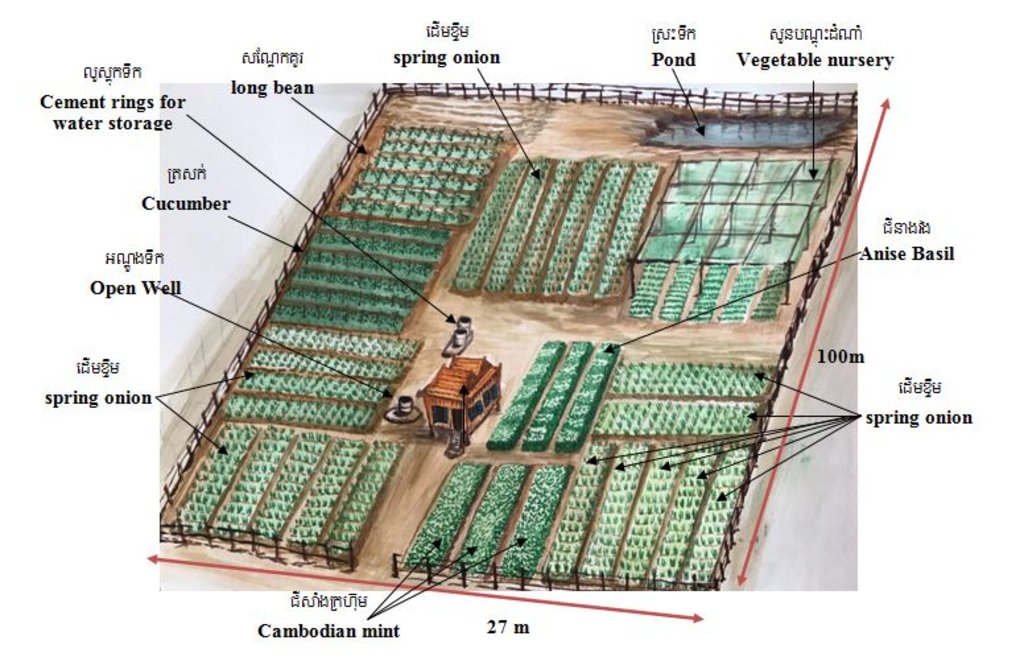Crop diversification with the application of rotation techniques [Cambodge]
- Création :
- Mise à jour :
- Compilateur : Navin Chea
- Rédacteurs : Sophea Tim, Sok Pheak
- Examinateurs : Nimul CHUN, Ursula Gaemperli, Alexandra Gavilano
Crop diversification farm
technologies_3145 - Cambodge
Voir les sections
Développer tout Réduire tout1. Informations générales
1.2 Coordonnées des personnes-ressources et des institutions impliquées dans l'évaluation et la documentation de la Technologie
Personne(s)-ressource(s) clé(s)
exploitant des terres:
Phrum Thon
Land User
Cambodge
Vice Chief of Agronomy Office at Agricultural Office of Rolea B'ier:
Chhim Bunleang
Agricultural Office of Rolea B'ier.
Cambodge
Vice Chief of Agricultural Extension Office at Provincial Department of Agriculture, Forestry and Fisheries, Kampong Chhnang province:
Chief of Agricultural Office of Tuek Phos:
Nom du projet qui a facilité la documentation/ l'évaluation de la Technologie (si pertinent)
Scaling-up SLM practices by smallholder farmers (IFAD)Nom du ou des institutions qui ont facilité la documentation/ l'évaluation de la Technologie (si pertinent)
Royal University of Agriculture (RUA) - Cambodge1.3 Conditions relatives à l'utilisation par WOCAT des données documentées
Le compilateur et la(les) personne(s) ressource(s) acceptent les conditions relatives à l'utilisation par WOCAT des données documentées:
Oui
1.4 Déclaration sur la durabilité de la Technologie décrite
Est-ce que la Technologie décrite ici pose problème par rapport à la dégradation des terres, de telle sorte qu'elle ne peut pas être déclarée comme étant une technologie de gestion durable des terres?
Non
2. Description de la Technologie de GDT
2.1 Courte description de la Technologie
Définition de la Technologie:
Crop diversification is the practice of simultaneously cultivating two or multiple varieties of crops in a given area whilst at the same time applying crop rotation and/or intercropping. In this case study the land user has been practicing crop diversification with eleven different crop varieties.
2.2 Description détaillée de la Technologie
Description:
Crop diversification entails simultaneously growing two or multiple varieties of crops in a particular place with the application of crop rotation techniques and/or intercropping. The selection of the crop varieties will depend on the purpose of the land user. In general, a diversity of crops will provide a range of benefits such as food security, nutritional diversity, income generation, soil conservation, pest and disease control as well as adaptation to climate change (CGIAR, 2017, Makate et al, 2016, MoEYS& VVOB Cambodia, 2013).
Mrs. Prum Thon has been cultivating a diversity of crops with the application of rotation techniquesfor about 10 years, which involves exchanging an entire crop in a particular row. This means that cultivation can take place throughout the year without having to leave the land fallow. At the time of the interview eleven different crops had been cultivated including spring onions, anise basil, Cambodian mint, bok choy, choy sum, escarole, mint, long beans, cucumbers, bitter melons and lettuce. Almost all of these crops have an average lifespan of three months, except for the anise basil which can grow for one or two years depending on the way it is cultivated. After she has harvested a particular crop, she will then rotate this crop row with a new distinctive crop species. For instance after having harvested spring onions she will then plant mint in that row, and in the row where she was previously growing mint, she will rotate that with either spring onions or cucumbers.
The practice of crop diversification whilst at the same time rotating the crop in each of the rows aims to achieve the following main objectives:
Crop diversification enables the farmer to generate a daily income to offset her daily expenses which thereby becomes a means of improving her livelihood. Growing a diversity of crops can also enable her to meet a variety of market demands and generate a high daily income. If a farmer grows only one crop specie she can usually earn about 15,000 Riel per day, but if she plants four crop species such as anise basil, bok choy, long beans and cucumbers she can increase her income to about 20,000 Riel per day, However if she grows one more specie such as lettuce or grows eleven different crops, she would be able to increase her income up to 40,000 or 80,000 Riel per day. The practice of crop diversification enables her to generate an income on a daily basis.
Crop diversification with the rotation of the crop in each row after the harvest could assist in reducing soil degradation. According to her experience and observations each crop absorbs different nutrients from the soil. If one row is repeatedly used to cultivate spring onions, they tend not to flourish so well and the roots have a tendency to decay. However if they are rotated with another crop and the spring onions are then grown in another row, they are able to thrive and the roots and stems are less likely to spoil. Crop diversification also has other functions as the cover crops help to reduce soil degradation through expose to sunlight, maintain soil moisture, make the soil less compact and add beneficial micro-organisms to the soil. In addition crop diversification can control pests especially the practice of growing companion plants such as herbs or spring onions as this can prevent crops from being damaged by pests.
The use of this technology assists in improving livelihoods, reduces migration because she does not need to move in order to find a job in another location, and enables her to generate a daily income. In addition this technology is able to reduce the risk of crop failure resulting from damage by pests and insects.Furthermore it reduces the risks associated with changes in market demand as the farmer produces a diversity of crops and also it prevents and reduces soil degradation. In order to effectively use this technology there needs to be sufficient water supply such as a river, stream, well or pond.This enables the land user to grow crops throughout the year round and reduces damage of crops as the result of unpredictable adverse climate conditions such as changes in rainfall, or the occurrence of drought.
2.3 Photos de la Technologie
2.5 Pays/ région/ lieux où la Technologie a été appliquée et qui sont couverts par cette évaluation
Pays:
Cambodge
Région/ Etat/ Province:
Ruessei Duoch village, Banteay Peal Commune, Rolea B'ier District, Kampong Chhnang Province.
Spécifiez la diffusion de la Technologie:
- répartie uniformément sur une zone
Si la Technologie est uniformément répartie sur une zone, précisez la superficie couverte (en km2):
0,0027
S'il n'existe pas d'informations exactes sur la superficie, indiquez les limites approximatives de la zone couverte:
- < 0,1 km2 (10 ha)
Commentaires:
It is spread over an area of 2700 square meters.
Map
×2.6 Date de mise en œuvre de la Technologie
Si l'année précise est inconnue, indiquez la date approximative: :
- il y a entre 10-50 ans
2.7 Introduction de la Technologie
Spécifiez comment la Technologie a été introduite: :
- grâce à l'innovation d'exploitants des terres
- au cours d'expérimentations / de recherches
- par le biais de projets/ d'interventions extérieures
Commentaires (type de projet, etc.) :
Through her experience and training from Cambodian Center for Study and Development in Agriculture (CEDAC).
3. Classification de la Technologie de GDT
3.1 Principal(aux) objectif(s) de la Technologie
- améliorer la production
- réduire, prévenir, restaurer les terres dégradées
- créer un impact économique positif
3.2 Type(s) actuel(s) d'utilisation des terres, là où la Technologie est appliquée

Terres cultivées
- Cultures annuelles
Cultures annuelles - Précisez les cultures:
- légumes - légumes-racines (carotte, oignon, betterave, autres)
- légumes - melon, citrouille, courge ou cucurbitacées
- légumes - légumes à feuilles (laitues, choux, épinards, autres)
- légumineuses et légumes secs - fèves
- plantes et herbes médicinales/ aromatiques/ pesticides
- cucumber
Système de cultures annuelles :
Légumes - blé/orge/avoine/riz sec
Nombre de période de croissance par an: :
- 3
Précisez:
Crop rotation throughout the whole year. The land is alway coverd by corps (no fallow period).
Est-ce que la rotation des cultures est appliquée?
Oui
Commentaires:
Spring onion, anise basil, Cambodian mint, bok choy, escarole, choy sum, mint, long bean, cucumber, bitter melon, lettuce.
3.3 Est-ce que l’utilisation des terres a changé en raison de la mise en œuvre de la Technologie ?
Est-ce que l’utilisation des terres a changé en raison de la mise en œuvre de la Technologie ?
- Oui (Veuillez remplir les questions ci-après au regard de l’utilisation des terres avant la mise en œuvre de la Technologie)

Forêts/ bois
Commentaires:
Degraded forest land.
3.4 Approvisionnement en eau
Approvisionnement en eau des terres sur lesquelles est appliquée la Technologie:
- mixte: pluvial-irrigué
Commentaires:
There is one open well and a pond for crop irrigation during drought.
3.5 Groupe de GDT auquel appartient la Technologie
- système de rotation (rotation des cultures, jachères, agriculture itinérante)
- gestion intégrée de la fertilité des sols
- lutte intégrée contre les ravageurs et les maladies (incluant l'agriculture biologique)
3.6 Mesures de GDT constituant la Technologie

pratiques agronomiques
- A1: Couverture végétale/ du sol
- A2: Matière organique/ fertilité du sol

structures physiques
- S5: Barrages/retenues, micro-bassins, étangs

autres mesures
Commentaires:
The farmer grows specific companion plants on the same plot with the aim of improving the plant growth and the pest control.
3.7 Principaux types de dégradation des terres traités par la Technologie

dégradation chimique des sols
- Cn: baisse de la fertilité des sols et réduction du niveau de matière organique (non causée par l’érosion)

dégradation physique des sols
- Pc: compaction

dégradation biologique
- Bc: réduction de la couverture végétale
- Bs: baisse de la qualité et de la composition/ diversité des espèces
- Bl: perte de la vie des sols
- Bp: augmentation des insectes nuisibles (ravageurs)/ maladies, baisse des prédateurs
3.8 Prévention, réduction de la dégradation ou réhabilitation des terres dégradées
Spécifiez l'objectif de la Technologie au regard de la dégradation des terres:
- prévenir la dégradation des terres
- réduire la dégradation des terres
Commentaires:
At the first time when she cultivated the land the soil was fertile. At that time she grew only cassava but she realized soon that if she grows always the same crop, the soil will be less fertile from year to year.
4. Spécifications techniques, activités, intrants et coûts de mise en œuvre
4.1 Dessin technique de la Technologie
Spécifications techniques (associées au dessin technique):
The total area on which the technology has been applied amounts to 2700 square meters (27 meters x 100 meters). Each of the diverse crop species such as spring onions, anise basil, bok choy, choy sum, escarole, Cambodian mint, long beans, bitter melons and lettuce have been divided into separate blocks.
The spring onion crop has been divided into 5 blocks out of which the first block measures 8.50 m x 8.50 m = 72.25 square meters and it contains a total of five rows. The length of each row is 8.50 m and width is 1.4 m and space between each row is 4 centimeters. The second block measures 14.60 m x 13 m= 189.3 square meters and it has been divided into two rows. Each row is 14.60 m in length and has a width of 1.4 m with a space of 4cm between the two rows. The third block measures 9.60 m x 3.90 m= 37.44 square meters and it contains 6 rows. Each of the rows is 9.60 m x 1.4 m and the space between each of the rows is 4 cm. The fourth block measures 6.35 m x 4.55 m= 28.89 square meters and it is divided into 4 rows. Each of the rows is 6.35 m in length and 1.4 m in width, and the space between each of the rows is 4 cm. The fifth block measures 11.60 m x 14.70 m = 170.52 square meters and it contains 6 rows. Each of the rows is 11.60 m in length, and 1.5 m in width and the space between each of the rows is 4 cm.
The block in which the anise basil is grown is 14.60 meters in length and 1.4 meters in width with a 4 cm space between the 3 rows. The block of cucumbers is divided into 6 rows with the length of each row being 10 meters and the width being0.5 meters. Each row rises to a height of about 1.5 cm and within the row the space between each cucumber clump is 0.5 cm. In the block of the long beans there are 6 rows with each row being 10 meters in length and 0.5 meters in width. Additionally the height of each row is 1.5 cm and space between each clump of long beans is 2 cm.
The nursery containing escarole, choy sum and lettuce is 14.60 meters x 13.50 meters and its roof has a height of 2 meters. There are two cement rings which also have a cement base that have been constructed for water storage. Each cement ring is 1 meter in height and 1 meter in diameter. Furthermore there is also one open well and a pond which provide water for domestic supply and the irrigation of crops.
Auteur:
Mr. Khoun Sophal
Date:
22/05/2017
4.2 Informations générales sur le calcul des intrants et des coûts
Spécifiez la manière dont les coûts et les intrants ont été calculés:
- par superficie de la Technologie
Indiquez la taille et l'unité de surface:
2700 square meters
autre/ monnaie nationale (précisez):
KHR
Indiquez le taux de change des USD en devise locale, le cas échéant (p.ex. 1 USD = 79.9 réal brésilien): 1 USD = :
4000,0
Indiquez le coût salarial moyen de la main d'œuvre par jour:
15000
4.3 Activités de mise en place/ d'établissement
| Activité | Calendrier des activités (saisonnier) | |
|---|---|---|
| 1. | Dig open well | During dry season |
| 2. | Dig pond | During dry season |
| 3. | Plough the soil two times and dry the soil by sunlight | After harvest |
| 4. | Buy crop seeds | At the beginning of soil preparation |
| 5. | Prepare pipe lines into cement rings | At the beginning of soil preparation |
| 6. | Buy net to cover the roof of the nursery house | At the beginning of soil preparation |
| 7. | Buy materials such as spit, handled basket, hoe ect | At the beginning of soil preparation |
4.4 Coûts et intrants nécessaires à la mise en place
| Spécifiez les intrants | Unité | Quantité | Coûts par unité | Coût total par intrant | % des coût supporté par les exploitants des terres | |
|---|---|---|---|---|---|---|
| Main d'œuvre | Plough the soil for the first and second time | person-day | 11,0 | 15000,0 | 165000,0 | 100,0 |
| Main d'œuvre | Clear land for growing 11 different crops | person-day | 15,0 | 15000,0 | 225000,0 | 100,0 |
| Main d'œuvre | Dig the open well and put the cement ring | person-day | 84,0 | 15000,0 | 1260000,0 | 100,0 |
| Main d'œuvre | Dig pond | person-day | 133,0 | 15000,0 | 1995000,0 | 100,0 |
| Equipements | Bamboo sticks | Piece | 50,0 | 1500,0 | 75000,0 | 100,0 |
| Equipements | Hoe | Piece | 2,0 | 17000,0 | 34000,0 | 100,0 |
| Equipements | Spit | Piece | 2,0 | 1300,0 | 2600,0 | 100,0 |
| Equipements | Handle basket to carry soil | Pair | 1,0 | 6000,0 | 6000,0 | 100,0 |
| Matériel végétal | Spring onion | Kilogram | 10,0 | 1000,0 | 10000,0 | 100,0 |
| Matériel végétal | Bok choy | Can | 12,0 | 1500,0 | 18000,0 | 100,0 |
| Matériel végétal | Escarole | Package | 2,0 | 10000,0 | 20000,0 | 100,0 |
| Matériel végétal | Choy Sum | Can | 5,0 | 1500,0 | 7500,0 | 100,0 |
| Matériel végétal | Anise basile | Package | 1,0 | 15000,0 | 15000,0 | 100,0 |
| Matériel végétal | Mint | Kilogram | 3,0 | 4000,0 | 12000,0 | 100,0 |
| Matériel végétal | Cambodian mint | Kilogram | 2,0 | 2500,0 | 5000,0 | 100,0 |
| Matériel végétal | Long bean | Kilogram | 1,0 | 60000,0 | 60000,0 | 100,0 |
| Engrais et biocides | Buy cow manure for the use of one year | Two wheel handle tractor | 10,0 | 70000,0 | 700000,0 | 100,0 |
| Engrais et biocides | Buy chicken manure for the use of one year | Bag | 20,0 | 4000,0 | 80000,0 | 100,0 |
| Engrais et biocides | Buy soil of termite mounds | Two wheel handle tractor | 10,0 | 40000,0 | 400000,0 | 100,0 |
| Engrais et biocides | Buy botanical pesticides | Liter | 6,0 | 4000,0 | 24000,0 | 100,0 |
| Engrais et biocides | Rice husk | Bag | 30,0 | 1500,0 | 45000,0 | 100,0 |
| Engrais et biocides | Buy Bat manure for soil preparation | Bag | 5,0 | 70000,0 | 350000,0 | 100,0 |
| Matériaux de construction | Water Pumping Machine | Piece | 2,0 | 880000,0 | 1760000,0 | 100,0 |
| Matériaux de construction | Cement rings which also have a cement base that have been constructed for water storage to irrigate crops. | Piece | 2,0 | 70000,0 | 140000,0 | 100,0 |
| Matériaux de construction | Net for making the roof to prevent sunlight and water. | Set | 2,0 | 220000,0 | 440000,0 | 100,0 |
| Autre | Cucumber | Can | 1,0 | 40000,0 | 40000,0 | 100,0 |
| Autre | Lettuce | Package | 5,0 | 15000,0 | 75000,0 | 100,0 |
| Autre | Bitter melon | Package | 2,0 | 5000,0 | 10000,0 | 100,0 |
| Coût total de mise en place de la Technologie | 7974100,0 | |||||
| Coût total de mise en place de la Technologie en dollars américains (USD) | 1993,53 | |||||
Commentaires:
Generally, the rate for digging a pond in Cambodia is USD 50 per hour if the contractor does not obtain the soil, but if he does the cost of digging the pond will be less. Cost calculations of this technology are based on crop cycles (the average lifespan of crop being three months with a diversity of eleven crops). The farmer uses her own labor force to implement this technology without hiring any external labor. In reference to the costs indicated in the table above, there may be minor errors compared to the actual costs because the land user did not make exact records, and the costs that were provided are only estimates.
4.5 Activités d'entretien/ récurrentes
| Activité | Calendrier/ fréquence | |
|---|---|---|
| 1. | Watering | Two times per day or three times per day depend on the weather. |
| 2. | Apply cow manure | When dig the soil near the crop root. |
| 3. | Apply bat manure | When dig the soil near the crop root. |
| 4. | Weeding | Once a week |
| 5. | Spraying pesticides | When there is insects. |
4.6 Coûts et intrants nécessaires aux activités d'entretien/ récurrentes (par an)
| Spécifiez les intrants | Unité | Quantité | Coûts par unité | Coût total par intrant | % des coût supporté par les exploitants des terres | |
|---|---|---|---|---|---|---|
| Main d'œuvre | When weeding, dig the soil near the crop root and apply fertilizer for elevent diversify of crops. | Person-day | 12,0 | 15000,0 | 180000,0 | 100,0 |
| Main d'œuvre | Spray pesticides | Person-day | 3,0 | 15000,0 | 45000,0 | 100,0 |
| Equipements | Diesel | liter | 10,0 | 3000,0 | 30000,0 | 100,0 |
| Engrais et biocides | Liquid fertilizer made of bat manure buying from fertilizer company. | liter | 1,0 | 70000,0 | 70000,0 | 100,0 |
| Coût total d'entretien de la Technologie | 325000,0 | |||||
| Coût total d'entretien de la Technologie en dollars américains (USD) | 81,25 | |||||
Commentaires:
The estimated maintenance costs base on one crop cycle of 3 months. It is not calculatee for the whole year. The land user does not hire wageworker as she is doing the work by herself and by the support of her husband.
4.7 Facteurs les plus importants affectant les coûts
Décrivez les facteurs les plus importants affectant les coûts :
Cow manure, chicken manure, rice husk, botanical pesticides has to be bought. Digging the pond and buying the water pumping machine are the most important factors affecting the costs. However these equipments are longlasting.
5. Environnement naturel et humain
5.1 Climat
Précipitations annuelles
- < 250 mm
- 251-500 mm
- 501-750 mm
- 751-1000 mm
- 1001-1500 mm
- 1501-2000 mm
- 2001-3000 mm
- 3001-4000 mm
- > 4000 mm
Spécifiez la pluviométrie moyenne annuelle (si connue), en mm:
1209,00
Spécifications/ commentaires sur les précipitations:
The annual rainfall in 2015 is 1209 mm. In 2014 is 1420.74 mm and in 2013 is 1367.5 mm
Indiquez le nom de la station météorologique de référence considérée:
Ministry of water resources and meteorology, 2015
Zone agro-climatique
- subhumide
There are two seasons: Rainy season and dry season.
5.2 Topographie
Pentes moyennes:
- plat (0-2 %)
- faible (3-5%)
- modéré (6-10%)
- onduleux (11-15%)
- vallonné (16-30%)
- raide (31-60%)
- très raide (>60%)
Reliefs:
- plateaux/ plaines
- crêtes
- flancs/ pentes de montagne
- flancs/ pentes de colline
- piémonts/ glacis (bas de pente)
- fonds de vallée/bas-fonds
Zones altitudinales:
- 0-100 m
- 101-500 m
- 501-1000 m
- 1001-1500 m
- 1501-2000 m
- 2001-2500 m
- 2501-3000 m
- 3001-4000 m
- > 4000 m
Indiquez si la Technologie est spécifiquement appliquée dans des:
- non pertinent
5.3 Sols
Profondeur moyenne du sol:
- très superficiel (0-20 cm)
- superficiel (21-50 cm)
- modérément profond (51-80 cm)
- profond (81-120 cm)
- très profond (>120 cm)
Texture du sol (de la couche arable):
- grossier/ léger (sablonneux)
Texture du sol (> 20 cm sous la surface):
- moyen (limoneux)
Matière organique de la couche arable:
- moyen (1-3%)
Si disponible, joignez une description complète du sol ou précisez les informations disponibles, par ex., type de sol, pH/ acidité du sol, capacité d'échange cationique, azote, salinité, etc.
PH=6
5.4 Disponibilité et qualité de l'eau
Profondeur estimée de l’eau dans le sol:
5-50 m
Disponibilité de l’eau de surface:
bonne
Qualité de l’eau (non traitée):
eau potable
La salinité de l'eau est-elle un problème? :
Non
La zone est-elle inondée?
Non
5.5 Biodiversité
Diversité des espèces:
- moyenne
Diversité des habitats:
- moyenne
5.6 Caractéristiques des exploitants des terres appliquant la Technologie
Sédentaire ou nomade:
- Sédentaire
Orientation du système de production:
- commercial/ de marché
Revenus hors exploitation:
- 10-50% de tous les revenus
Niveau relatif de richesse:
- moyen
Individus ou groupes:
- individu/ ménage
Niveau de mécanisation:
- travail manuel
- mécanisé/ motorisé
Genre:
- femmes
Age des exploitants des terres:
- personnes âgées
Indiquez toute autre caractéristique pertinente des exploitants des terres:
In this technology only two persons are involved in the technology (husband and wife). The interviewee is the wife is 50 years old. She finished grade 8.
5.7 Superficie moyenne des terres utilisées par les exploitants des terres appliquant la Technologie
- < 0,5 ha
- 0,5-1 ha
- 1-2 ha
- 2-5 ha
- 5-15 ha
- 15-50 ha
- 50-100 ha
- 100-500 ha
- 500-1 000 ha
- 1 000-10 000 ha
- > 10 000 ha
Cette superficie est-elle considérée comme de petite, moyenne ou grande dimension (en se référant au contexte local)?
- moyenne dimension
Commentaires:
The technology is applied on 2,700 square meters. The homeland is 3,900 square meters. Degraded forest land is 8,250 square meters and rice paddy field is 0.50 hectare.
5.8 Propriété foncière, droits d’utilisation des terres et de l'eau
Propriété foncière:
- individu, avec titre de propriété
Droits d’utilisation des terres:
- individuel
Droits d’utilisation de l’eau:
- individuel
5.9 Accès aux services et aux infrastructures
santé:
- pauvre
- modéré
- bonne
éducation:
- pauvre
- modéré
- bonne
assistance technique:
- pauvre
- modéré
- bonne
emploi (par ex. hors exploitation):
- pauvre
- modéré
- bonne
marchés:
- pauvre
- modéré
- bonne
énergie:
- pauvre
- modéré
- bonne
routes et transports:
- pauvre
- modéré
- bonne
eau potable et assainissement:
- pauvre
- modéré
- bonne
services financiers:
- pauvre
- modéré
- bonne
6. Impacts et conclusions
6.1 Impacts sur site que la Technologie a montrés
Impacts socio-économiques
Production
production agricole
Commentaires/ spécifiez:
The crop diversification and the subsequent cultivation of vegetables and herbs during the whole year, as well as the distinct crop rotational plan increased considerably her crop production.
qualité des cultures
Commentaires/ spécifiez:
The application of natural fertilizers and botanical pesticides, as well as the method of crop rotation and selection of companion plants led to better crop quality.
risque d'échec de la production
Commentaires/ spécifiez:
Due to the permanent soil cover, the high crop diversification and the sophisticated pest control the risk of production failure decreased.
diversité des produits
Commentaires/ spécifiez:
There are diversify of crops and grow all year round.
Disponibilité et qualité de l'eau
demande pour l'eau d'irrigation
Commentaires/ spécifiez:
The plantation of a large variety of vegetables and herbs all year round let to higher irrigation water demand especially during the dry season or at drought events.
Revenus et coûts
dépenses pour les intrants agricoles
Commentaires/ spécifiez:
The crop diversification requires a lot of monetary inputs mainly for the establishment and also for the maintenance (labor for digging the pond, water pumping machine, natural fertilizers has to be bought - she does not raise animals).
revenus agricoles
Commentaires/ spécifiez:
Although the land user had to invest a lot of money for this technology, she got and get still better and regular daily income from the sale of the wide range of different crops at the market compared to what she earned before. All in all she was able to improve the household's livelihood.
charge de travail
Commentaires/ spécifiez:
This technology is sophisticated and rather time consuming compared to conventional growing methods (mono-cropping of cassava for example). In this case study the land user invests only her own and her husband's labor force.
Impacts socioculturels
sécurité alimentaire/ autosuffisance
Commentaires/ spécifiez:
The self sufficiency increased as she gets every day her own vegetables from the vegetable plot. And at a daily base she gets money from the sale of her vegetables to meet all needs of the household. Further, she was able to reduce the risk of crop failure which increased the food security.
situation sanitaire
Commentaires/ spécifiez:
The health situation of the farmer and her husband were improved as the production is near to be fully organic very low use of chemical pesticides/biocides. And by the health production she supports also the health of the other consumers.
connaissances sur la GDT/ dégradation des terres
Commentaires/ spécifiez:
The land user got a broad knowledge about the crop diversification and crop rotation technology. Mainly regarding the reduction of chemical soil degradation and regarding how to support better plant growth.
Impacts écologiques
Cycle de l'eau/ ruissellement
qualité de l'eau
Commentaires/ spécifiez:
Due to very low application of chemical pesticides.
évaporation
Commentaires/ spécifiez:
Due to the improved soil cover by the different vegetables and herbs all year long the evaporation deceased.
Sols
humidité du sol
Commentaires/ spécifiez:
Soil moisture increased due to the improved soil cover that could reduce evaporation into environment.
compaction du sol
Commentaires/ spécifiez:
The soil compaction is less due to better soil moisture, crop rotation and using natural fertilizers.
matière organique du sol/ au dessous du sol C
Commentaires/ spécifiez:
The soil organic matter increased due to the application of natural fertilizers.
Biodiversité: végétale, animale
Couverture végétale
Commentaires/ spécifiez:
All year long the soil is covered by different vegetables and herbs.
diversité végétale
Commentaires/ spécifiez:
Before she has cultivated only one crop on the area but she grows now eleven different vegetables and herbs.
espèces bénéfiques
Commentaires/ spécifiez:
The soil life increased regarding bacteria and fungi, earthworm, ant, and centipede due to the crop rotation system and the use of natural fertilizers and botanical pesticides.
diversité des habitats
Commentaires/ spécifiez:
The nearly organic cultivation provides a habitat for a large variety of soil organisms such as earthworm, termites or ants.
contrôle des animaux nuisibles/ maladies
Commentaires/ spécifiez:
The pest and disease control is improved due to the rotational system, the use of botanical pesticides, and the cultivation of companion plants such as anise basil, Cambodian mint and spring onions.
6.3 Exposition et sensibilité de la Technologie aux changements progressifs et aux évènements extrêmes/catastrophes liés au climat (telles que perçues par les exploitants des terres)
Changements climatiques progressifs
Changements climatiques progressifs
| Saison | Augmentation ou diminution | Comment la Technologie fait-elle face à cela? | |
|---|---|---|---|
| températures annuelles | décroît | bien | |
| températures saisonnières | saison des pluies/ humide | décroît | bien |
| températures saisonnières | saison sèche | augmente | bien |
| précipitations annuelles | décroît | bien | |
| précipitations saisonnières | saison des pluies/ humide | décroît | bien |
Extrêmes climatiques (catastrophes)
Catastrophes climatiques
| Comment la Technologie fait-elle face à cela? | |
|---|---|
| sécheresse | bien |
Catastrophes biologiques
| Comment la Technologie fait-elle face à cela? | |
|---|---|
| maladies épidémiques | modérément |
| infestation par des insectes/ vers | bien |
6.4 Analyse coûts-bénéfices
Quels sont les bénéfices comparativement aux coûts de mise en place (du point de vue des exploitants des terres)?
Rentabilité à court terme:
positive
Rentabilité à long terme:
positive
Quels sont les bénéfices comparativement aux coûts d'entretien récurrents (du point de vue des exploitants des terres)?
Rentabilité à court terme:
positive
Rentabilité à long terme:
positive
6.5 Adoption de la Technologie
- 11-50%
Si disponible, quantifiez (nombre de ménages et/ou superficie couverte):
7 families
De tous ceux qui ont adopté la Technologie, combien d'entre eux l'ont fait spontanément, à savoir sans recevoir aucune incitation matérielle, ou aucune rémunération? :
- 91-100%
6.6 Adaptation
La Technologie a-t-elle été récemment modifiée pour s'adapter à l'évolution des conditions?
Non
6.7 Points forts/ avantages/ possibilités de la Technologie
| Points forts/ avantages/ possibilités du point de vue de l'exploitant des terres |
|---|
| Provides a daily income. |
| The quality of the soil is better through crop rotation and the exchange of crops in the rows. Additionally cow manure and soil from the termite mound can be used as fertilizer. |
| The actual work can be done by oneself which involves physical exercise and is good for one’s health. |
| Points forts/ avantages/ possibilités du point de vue du compilateur ou d'une autre personne ressource clé |
|---|
| Grow a diversity of crops which reduces the risk of production failure from damaging from insects, disease and market. |
| The farmer is able to generate a daily income, thereby improving her livelihood and it gives her the means to cope with her daily expenses. |
| Crop rotation could reduce soil degradation. |
| Reduces migration as now she has her own job and as this technology improves her livelihood. |
6.8 Faiblesses/ inconvénients/ risques de la Technologie et moyens de les surmonter
| Faiblesses/ inconvénients/ risques du point de vue de l’exploitant des terres | Comment peuvent-ils être surmontés? |
|---|---|
| During some months it is not possible to grow herbage vegetables. | Can grow other crops such as anise basil. |
| She has to water the crops only by herself which is very exhausting | Must try harder. |
| Faiblesses/ inconvénients/ risques du point de vue du compilateur ou d'une autre personne ressource clé | Comment peuvent-ils être surmontés? |
|---|---|
| Farmer spends a lot of time for watering the crops. | Could change and start using a sprinkler or drip irrigation system in order to reduce labor. |
| Must properly record expenses and income so as to verify the net income. | Provide training in recording income and expenses. |
7. Références et liens
7.1 Méthodes/ sources d'information
- visites de terrain, enquêtes sur le terrain
One specific location where the technology applied.
- interviews/entretiens avec les exploitants des terres
one person
- interviews/ entretiens avec les spécialistes/ experts de GDT
3 persons
Quand les données ont-elles été compilées (sur le terrain)?
22/05/2017
7.3 Liens vers les informations pertinentes en ligne
Titre/ description:
CGIAR. (2017). Crop diversification strategies for Cambodia, Laos and Vietnam. Retrieved December 11, 2017, from
URL:
https://ccafs.cgiar.org/blog/crop-diversification-strategies-cambodia-laos-and-vietnam#.Wi4Hu1WWbIU
Titre/ description:
Makate, C., Wang, R., Makate, M., & Mango, N. (2016). Crop diversification and livelihoods of smallholder farmers in Zimbabwe: adaptive management for environmental change. SpringerPlus, 5(1), 1135.Retrieved December 11, 2017, from
URL:
https://doi.org/10.1186/s40064-016-2802-4
Titre/ description:
MAFF. (2006). Technology stardardize: Home gardening. In Khmer. (Ministry of Agriculture, Forestry and Fisheries). Phnom Penh. Retrieved December 11, 2017, from
URL:
https://drive.google.com/file/d/0B3kkBprEzhDoMWtPeXZUNE4teTQ/preview
Titre/ description:
MoEYS & VVOB Cambodia. (2013). Teaching Methodology for Agricultural Life Skills Education for Teacher Training Centers:Part 3 Organic gardening (1st editio). Phnom Penh: Ministry of Education, Youth and Sport. Retrieved December 11, 2017, from
URL:
http://www.vvob.be/cambodia/sites/default/files/content_manual_part_3_organic_gardening.pdf
Liens et modules
Développer tout Réduire toutLiens
Aucun lien
Modules
Aucun module trouvé


